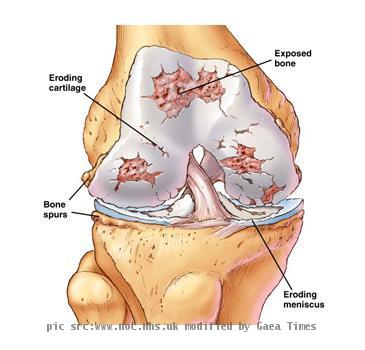Special mobility shoes can help ease knee pain, slow down osteoarthritis
By ANIMonday, November 8, 2010
WASHINGTON - A study has suggested that use of special mobility shoes can help ease knee pain and slow disease progression in people with osteoarthritis.
Osteoarthritis, or OA as it is commonly called, is the most common joint disease affecting middle age and older people. It is characterized by progressive damage to the joint cartilage, the cushioning material at the end of long bones, and causes changes in the structures around the joint.
These changes can include fluid accumulation, bony overgrowth, and loosening and weakness of muscles and tendons, all of which may limit movement and cause pain and swelling.
“Forces on the knee joint during walking have been shown to be related to pain, severity and progression of knee osteoarthritis,” Najia Shakoor, associate professor of medicine at Rush University in Chicago and lead investigator in the study, explained.
“Therefore, researchers currently investigate strategies to reduce these forces or loads on the knee joint in hopes of preventing progression of the disease,” Shakoor stated.
At the beginning of the study, researchers used a special camera system and a force plate to determine gait (how a person walks) in 16 participants (who were all diagnosed with knee OA through X-rays and based on symptoms) while they walked in their own shoes, in mobility shoes, and barefoot.
After this initial evaluation, participants were instructed to wear the mobility shoes a minimum of six hours per day, six days a week for six months.
To determine the progression of each participant, researchers performed the same gait analysis that was performed at the beginning of the study at six, 12 and 24 weeks.
Overall, researchers determined that mobility shoes, in comparison to conventional shoes, led to significantly decreased knee loads in the participants.
Additionally, they found that longer-term use of the mobility shoes led to even better outcomes in participants - noting a reduction in knee load that increased from 3.7 percent at the beginning of the study to 9.4 percent after six weeks, and to 18 percent at six months.
Finally, researchers found that after 24 weeks of wearing mobility shoes, participants experienced an adaptation in their gait (with a knee load reduction of 11 percent) even when wearing conventional shoes - leading researchers to believe that the use of mobility shoes could create beneficial neuromuscular and behavioural changes in how people with OA walk.
“This study showed that specialized footwear was beneficial in reducing knee loads substantially over six months,” Shakoor added.
The findings have been presented at the American College of Rheumatology Annual Scientific Meeting in Atlanta. (ANI)
